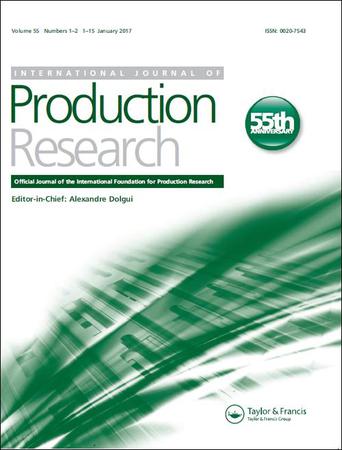Quality design based on kernel trick and Bayesian semiparametric model for multi-response processes with complex correlations
IF 7
2区 工程技术
Q1 ENGINEERING, INDUSTRIAL
International Journal of Production Research
Pub Date : 2023-09-30
DOI:10.1080/00207543.2023.2262065
引用次数: 0
Abstract
ABSTRACTProcesses or products are typically complex systems with numerous interrelated procedures and interdependent components. This results in complex relationships between responses and input factors, as well as complex nonlinear correlations among multiple responses. If the two types of complex correlations in the quality design cannot be properly dealt with, it will affect the prediction accuracy of the response surface model, as well as the accuracy and reliability of the recommended optimal solutions. In this paper, we combine kernel trick-based kernel principal component analysis, spline-based Bayesian semiparametric additive model, and normal boundary intersection-based evolutionary algorithm to address these two types of complex correlations. The effectiveness of the proposed method in modeling and optimisation is validated through a simulation study and a case study. The results show that the proposed Bayesian semiparametric additive model can better describe the process relationships compared to least squares regression, random forest regression, and support vector basis regression, and the proposed multi-objective optimisation method performs well on several indicators mentioned in the paper.KEYWORDS: Quality designBayesian inferencerandom walk priortensor B splinesemiparametric additive model Disclosure statementNo potential conflict of interest was reported by the author(s).Data availability statementThe data used to support the findings of the case study can be downloaded from the website https://figshare.com/articles/dataset/DATA_xlsx/22567336.Additional informationFundingThis work is supported by National Natural Science Foundation of China [grant numbers: 72301002, 72071001, 72171118]; Humanities and Social Sciences Planning Project of the Ministry of Education [grant numbers: 20YJAZH066, 21YJCZH148]; Excellent Young Talent Project of in Colleges and Universities of Anhui Province [grant number: gxyqZD2022001]; Science and Technology Project of Jiangxi Provincial Education Department [grant number: GJJ210528].Notes on contributorsShijuan YangShijuan Yang is a lecturer of School of Business at Anhui University, Hefei, China. She earned her Ph.D in Quality Management and Quality Engineering from Nanjing University of Science and Technology, China. Her research interests include applied statistics and quality management.Jianjun WangJianjun Wang is a Professor at the Department of Management Science and Engineering, Nanjing University of Science and Technology, China. He is a senior member of the Chinese Society of Optimization, Overall Planning, and Economical Mathematics. He is a reviewer of several international journals such as JQT, EJOR, IJPR, CAIE, and QTQM. His current research interests include quality engineering and quality management, robust parameter design, Bayesian modeling and optimisation, and industrial statistics.Xiaoying ChengXiaoying Chen is a Ph.D. candidate in Quality Management and Quality Engineering from Nanjing University of Science and Technology, China. Her research interests include Bayesian statistics and quality management and quality engineering.Jiawei WuJiawei Wu is a full lecturer at the School of Information Management, Jiangxi University of Finance and Economics, Nanchang, China. He has held visiting appointments at the University of Toronto in Canada. He has authored or coauthored more than 15 journal papers in the fields of quality and reliability engineering, optimisation design, and product development.Jinpei LiuJinpei Liu is a professor of School of Business at Anhui University, China. He received his Ph.D. in management science and engineering from Tianjin University in 2012, an MSc in probability and operations research from Anhui University in 2008 and a BSc in Statistics from Anhui University in 2005. His current research interests include forecasting, applied statistics and big data analysis. He is a reviewer of some famous international journals such as EJOR, CAIE, IEEE TEM and IEEE TFS.基于核技巧和贝叶斯半参数模型的复杂关联多响应过程质量设计
过程或产品是典型的复杂系统,具有许多相互关联的过程和相互依赖的组件。这导致了响应与输入因素之间的复杂关系,以及多个响应之间复杂的非线性相关性。如果在质量设计中不能处理好这两类复杂关联,将会影响响应面模型的预测精度,也会影响推荐最优解的精度和可靠性。本文结合基于核技巧的核主成分分析、基于样条的贝叶斯半参数加性模型和基于法向边界相交的进化算法来解决这两类复杂关联。通过仿真研究和实例分析,验证了该方法在建模和优化方面的有效性。结果表明,与最小二乘回归、随机森林回归和支持向量基回归相比,所提出的贝叶斯半参数加性模型能更好地描述过程关系,所提出的多目标优化方法在文中提到的几个指标上表现良好。关键词:质量设计贝叶斯推理随机游走先验张量B样条半参数加性模型披露声明作者未报告潜在的利益冲突。数据可得性声明支持本案例研究结果的数据可从https://figshare.com/articles/dataset/DATA_xlsx/22567336.Additional网站下载。基金资助:国家自然科学基金项目[资助号:72301002,72071001,72171118];教育部人文社科规划项目[批准号:20YJAZH066, 21YJCZH148];安徽省高校优秀青年人才项目[批准号:gxyqZD2022001];江西省教育厅科技项目[批准号:GJJ210528]。作者简介杨世娟,安徽大学商学院讲师。她在南京理工大学获得质量管理与质量工程博士学位。主要研究方向为应用统计学和质量管理。王建军,南京理工大学管理科学与工程系教授。他是中国优化、总体规划与经济数学学会高级会员。他是JQT、EJOR、IJPR、CAIE、QTQM等多家国际期刊的审稿人。他目前的研究兴趣包括质量工程和质量管理、鲁棒参数设计、贝叶斯建模和优化以及工业统计。陈晓颖,南京理工大学质量管理与质量工程专业博士研究生。主要研究方向为贝叶斯统计、质量管理和质量工程。吴佳伟,江西财经大学信息管理学院讲师。他曾在加拿大多伦多大学担任访问学者。他在质量和可靠性工程、优化设计和产品开发领域撰写或合作撰写了超过15篇期刊论文。刘金培,中国安徽大学商学院教授。他于2012年获得天津大学管理科学与工程博士学位,2008年获得安徽大学概率论与运筹学硕士学位,2005年获得安徽大学统计学学士学位。他目前的研究方向包括预测、应用统计和大数据分析。担任EJOR、CAIE、IEEE TEM、IEEE TFS等国际知名期刊的审稿人。
本文章由计算机程序翻译,如有差异,请以英文原文为准。
求助全文
约1分钟内获得全文
求助全文
来源期刊

International Journal of Production Research
管理科学-工程:工业
CiteScore
19.20
自引率
14.10%
发文量
318
审稿时长
6.3 months
期刊介绍:
The International Journal of Production Research (IJPR), published since 1961, is a well-established, highly successful and leading journal reporting manufacturing, production and operations management research.
IJPR is published 24 times a year and includes papers on innovation management, design of products, manufacturing processes, production and logistics systems. Production economics, the essential behaviour of production resources and systems as well as the complex decision problems that arise in design, management and control of production and logistics systems are considered.
IJPR is a journal for researchers and professors in mechanical engineering, industrial and systems engineering, operations research and management science, and business. It is also an informative reference for industrial managers looking to improve the efficiency and effectiveness of their production systems.
 求助内容:
求助内容: 应助结果提醒方式:
应助结果提醒方式:


